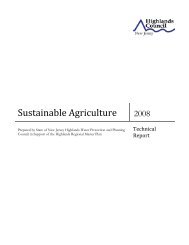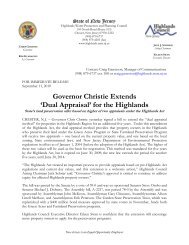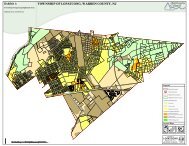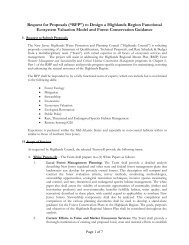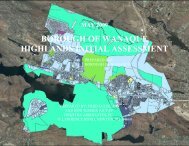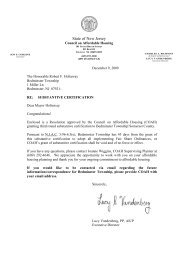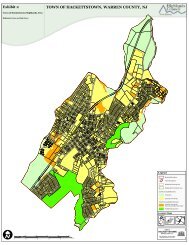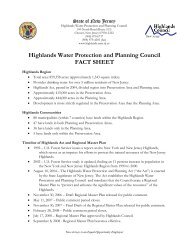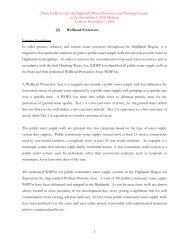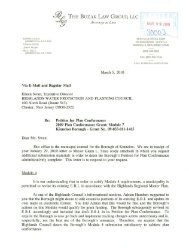Township of Rockaway DRAFT Highlands Element for Municipal ...
Township of Rockaway DRAFT Highlands Element for Municipal ...
Township of Rockaway DRAFT Highlands Element for Municipal ...
You also want an ePaper? Increase the reach of your titles
YUMPU automatically turns print PDFs into web optimized ePapers that Google loves.
<strong>DRAFT</strong> <strong>Highlands</strong> <strong>Element</strong> to the <strong>Rockaway</strong> <strong>Township</strong> Master Plan November 2010<br />
K. LOW IMPACT DEVELOPMENT<br />
This Plan embraces the concept <strong>of</strong> Low Impact Development (LID) and seeks to ensure its<br />
maximum use in land development activities throughout the <strong>Highlands</strong> Area. LID<br />
encompasses a broad array <strong>of</strong> development and management techniques that can minimize<br />
or mitigate the potential adverse impacts <strong>of</strong> land use and development on the natural<br />
environment. LID is used in stormwater management, resource management, “green”<br />
building, and sustainable site design. In stormwater management <strong>for</strong> example, LID<br />
techniques can be employed to capture rainfall, filter it through existing vegetation, and<br />
maximize its absorption by on-site soils in order to recharge ground water supplies. In site<br />
design, LID would incorporate strategies to reduce site disturbance, limit impervious<br />
coverage, and integrate existing natural features affecting the site and/or its immediate<br />
surroundings into the proposed layout and design.<br />
To accomplish such aims, specific LID standards should be developed and incorporated into<br />
<strong>Township</strong> land use regulations. Because LID practices and innovations continue to emerge,<br />
these should include, but by no means be limited to the following:<br />
1. Stormwater management LID standards that preserve or mimic the natural<br />
hydrologic features and characteristics <strong>of</strong> the land.<br />
a. Use <strong>of</strong> stormwater management features that maintain, restore and enhance the<br />
pre-existing natural drainage patterns <strong>of</strong> the site.<br />
b. Limitations on impervious coverage allowances to maximize stormwater<br />
infiltration and reduce run<strong>of</strong>f.<br />
c. Requirements <strong>for</strong> site-specific hydrologic studies which identify the velocity,<br />
volume and pattern <strong>of</strong> water flow into, through and flowing from a parcel<br />
proposed <strong>for</strong> development.<br />
d. Requirements that stormwater management systems employ a “design with<br />
nature” approach by use <strong>of</strong> grass channels, dry swales, wet swales (vegetated<br />
channels designed to retain water or marshy conditions that support wetland<br />
vegetation), infiltration basins, bio-swales and water gardens, constructed<br />
wetlands, green ro<strong>of</strong>s, and other low impact approaches to attenuate and<br />
control stormwater and provide multiple environmental benefits.<br />
2. LID practices that minimize land disturbance during construction activities.<br />
a. Requirements <strong>for</strong> site-specific analysis <strong>of</strong> environmental features and<br />
constraints as an integral component <strong>of</strong> site design.<br />
b. Limitations on site disturbance, soil compaction, clearing and grading to the<br />
minimum necessary to allow <strong>for</strong> permissible development.<br />
- 39 -



